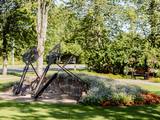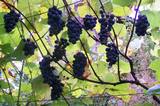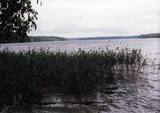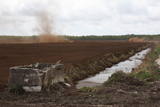| Нo | Название | Описание |
|---|---|---|
|
Öun Drinks производит прохладительные лимонады и сидры из эстонского яблочного сока. Здесь Вы сможете не только попробовать, но и понаблюдать за процессом приготовления лимонада. Лимонад можно и дегустировать, и покупать навынос. |
||
|
Parkā blakus pusloka tiltiņam ir novietotas trīs milzīgas dzelzs atslēgas, kuras balsta akmens mūris un metāla arkas. Tās simbolizē trīs vēsturiskos centrus un to vienotību – Siguldu, Turaidu, Krimuldu. Dobēs pie šī objekta sezonāli zied dažādi kultūraugi. |
||
|
Auces novads miniatūrā izveidots ar Auces novada nozīmīgākajiem un atpazīstamākajiem objektiem miniatūrā, kuri apdzīvoti ar mājdzīvniekiem. Iespēja Auces novada iedzīvotājiem un viesiem izveidot saikni ar dabu un vienlaicīgi iepazīt Auces novadu. Mazajiem apmeklētājiem izglītojoša saikne ar dzīvniekiem, iespēja tos pabarot ar saimnieku sarūpētajām veltēm. Veicināta Auces novada atpazīstamība caur miniatūriem objektiem. Tiek piedāvāta ekskursija, kuras laikā iespējams apskatīt 4 saimniecības: Zemnieku saimniecību ‘’Skabargas”, Lauku sētu ‘’Krastiņos’’, saimniecību ‘’Andulaiši’ un Lauku sētu ‘’Baltiņi’’. Ekskursija notiek gida pavadībā. Tiek gaidīti viesi, grupās no 10 cilvēkiem, ar iepriekšēju pieteikšanos. |
||
|
Комплекс отдыха расположен на берегу искусственного водохранилища, на территории имеются две бани - Большая и Малая. Здания Большой и Малой бани предусмотрены для проведения торжеств и различных мероприятий. Вместимость Большой бани до 40 человек, в летний сезон - до 60, а Малой бани - до 20 человек. Кроме бань предлагаются 20 мест для всевозможного отдыха: столики, гриль, места для палаток, волейбольная площадка, прокат лодок и водного велосипеда. |
||
|
After passing through Sigulda, the Forest Trail follows the River Vējupīte to Paradīzes Hill, where a steep staircase leads down into the ancient valley of the River Gauja and the ravine of the River Vējupīte. It continues to wind down smaller paths through meadows, crossing small rivers whose banks reveal sandstone outcrops. The last six kilometres of this section follow a smaller path down the Līgatne Nature Trails. You can see local wildlife animals and birds on this 5.5 km long trail. Further on the Forest Trail moves up the hills of the ancient valley of the River Gauja, before descending back down into the deep ravine of the River Līgatne, where the village of the former Līgatne paper mill is located. You can explore this attractive small village, visit the Līgatne spoon factory, winery and Līgatne caves. There is also the Līgatne Net Park with 4-7 m high net labyrinths among the treetops. This part of the Forest Trail and Gauja National Park is characterised by a gradual transition from diverse, deciduous forests (ash, grey alder, oak, birch, linden) to coniferous stands. |
||
|
В хозяйстве выращивают овец, кроликов, лошадей, африканских страусов и других домашних птиц, а также грибы шиитаки. Здесь можно заказать и приобрести грибы, сувениры из страусиного пера и другую сельскохозяйственную продукцию. |
||
|
Из Риги маршрут идет на козью ферму, где можно пообщаться с милыми смешными животными и отведать эксклюзивные сыры. Затем посетите поместье Малпилс и отведайте ассорти из местных сыров, изготовленных из коровьего молока. Потом маршрут поворачивает в сторону реки Даугавы и ведет в Скривери, где можно попробовать восхитительное домашнее мороженое и традиционные ириски «Коровка» ручной работы. А затем направляйтесь к развалинам легендарного Кокнесского замка. На следующий день маршрут идет в этнографическое действующее фермерское хозяйство, расположенное в живописном местечке под названием Яунпиебалга, и в семейное предприятие по производству сыра и макаронных изделий в Рауне. Неподалеку находится производство глиняных изделий, расположенное в стенах бывшего кирпичного завода, где можно понаблюдать за тем, как вручную изготавливаются керамические изделия. Затем вас ждет осмотр достопримечательностей в Цесисе, с его Старым городом и средневековым замком Ливонского Ордена. А далее, маршрут ведет на ферму, где выращивают коноплю, и где вы сможете попробовать ее, приготовленную традиционным способом. Далее по плану экскурсия и дегустация на фабрике мороженого в Руйиене. Остановитесь на бывшей мельнице, где до сих пор используется и можно посмотреть старинное оборудование для обработки шерсти. На пути обратно в Ригу, маршрут ведет вдоль побережья. Посетите музей величайшего в мире лгуна – Мюнгхаузена, где вас развлекут историями о его фантастических приключениях, навестите ловцов миног и прогуляйтесь по песчаному пляжу. |
||
|
Бывшая узкоколейка – сохранилось место станции, багажный склад, жилое
здание начальника станции, а также само «полотно» маленького паровозика.
|
||
|
В хозяйстве из ревеня, березового сока и яблок делают домашнее вино. Посетители могут ознакомиться с винодельней и процессом производства. Дегустация и покупка продукции. |
||
|
Находится в стороне от площади Куршу, ул. Э.Венденбаума, д. 1. Старейшая церковь города, сведения о которой сохранились с 1508 года. Первый храм на этом месте был построен из дерева. После неоднократных перестроек (последняя – в 1893 г. под руководством архитектора Лиепаи Пауля Макса Берчи) храм приобрел теперешний вид в неоготическом стиле с башней высотой около 60 м. Церковный интерьер славится одним из самых выдающихся шедевров времен барокко в Латвии – алтарем (резчик по дереву Николя Сефренс младший), который в 2012 году отметил свое 350-летие.Алтарь считается одной из самых выдающихся работ Восточной Европы того времени. Ретабло алтаря (5,8 x 9,7 м) известно тематическим циклом страданий Иисуса. В храме находится третий по величине орган Латвии, который построен по эскизам композитора и органиста Альфреда Калниньша. Церковь можно осмотреть изнутри и подняться на колокольню. |
||
|
Eine alte Ortschaft am linken Ufer des Flusses Nemunas. Liškiava-Kirche und Kloster, heiliger Berg und Burgberg mit den Ruinen der am Ende des 14. Jh unter Leitung von Vytautas der Großen gebauten Burg. Ein Kultstein mit einem Kühstapfen.
|
||
|
Tas atrodas pie „Burtnieku” mājām Īlē, kur viņš dzīvojis no 1837. – 1845. gadam. Tēvs Juris Barons apglabāts Īles kapsētā. Savu vārdu nemirstīgu Krišjānis Barons darījis, vācot, sistematizējot un sastādot Latvju Dainu krājumu. Tautasdziesmas jeb dainas ir mazi, ritmiski dzejolīši, parasti četrrindes. Pie Latvju dainu vākšanas Barons pavadījis sava mūža lielāko daļu – apmēram 25 gadus gandrīz dienu pie dienas. |
||
|
The visitors are offered the excursion around the wine garden and the story about different sorts of grapes and the secrets of wine-making. During the excursion the vistiors can learn about the traditions of growing grapes in Latvia, to see and taste the newest tendencies of grape selectioning,as well as receive advice on growing and tending grapes. It is also possible to try home-made wines and buy grapes saplings. |
||
|
A very beautiful and expressive tree, it is found on the land of what was once the Vīceži Semi-estate.
|
||
|
Кемерская водонапорная башня –
построена в 1929 году. В свое время в башне
хранились запасы питьевой и минеральной
воды. До Второй мировой войны гости курорта
могли любоваться окрестностями Кемери с
высоты 42метровой площадки, которая была
обустроена на самом верху башни.
|
||
|
Ap 9,5 km garais un līdz kilometru platais ezers atrodas subglaciālā – t.i. ledāja veidotā vagā, tādēļ tas ir ne tikai Lietuvas, bet arī otrs Baltijas dziļākais ezers (pēc dažādiem avotiem 60,5 m vai 62,5 m). Tauragna dienvidu krastā paceļas Taurapils pilskalns (Taurapilio piliakalnis). Saglabājušies nostāsti gan par pagānu priesteri, kas te dzīvojis, gan nogrimušu baznīcu, gan laikiem, kad pilskalnu no visām pusēm apņēmis ūdens. No pilskalna plakuma paveras visaptverošs skats uz Tauragnu. |
||
|
The tower on the eastern shore of Lake Engure (next to the meadow for wild cattle, accessible from the side of Bērzciems) offers a view of the reeds, small islands, Great Island, cows and horses of the north-eastern part of the lake. The tower on the northern shore of the lake (accessible from the side of Mērsrags) offers a look at the boating facility and the very overgrown northern part of the lake. The tower at the north-western shore of the lake (accessible from the side of Ķūļciems) shows the Apaļrova island (a footpath), stands of juniper, the boating facility, and the mosaic-like landscape of the lake itself.
|
||
|
Предлагается рыбалка на озере Усмас. Из улова хозяйка готовит вкусную уху и коптит рыбу. Лодка напрокат, рыбалка, вытягивание сети (даже зимой), катание на катере по озеру. Дегустации консервов, сделанных из копченого леща. Верховая езда. |
||
|
Nature restricted area is established to protect various wetland habitats – Big Kirba Bog and protected plant species within it. Only the West part of the Bog is a protected nature area. The rest of the bog is used mainly for intensive extraction of peat and large cranberry cultivation. Nature restricted area of the bog has no tourism infrastructure therefore is not useable for tourist visits.
|
||
|
The origins of the castle that was built in the style of Classicism date back to 1784. Later it was rebuilt into a two-story building with a portico with four columns at its centre. A new period in the development of the state began in 1993, when restoration of the buildings began. The estate currently houses a children’s village, while the mansion is now a hotel.
|
||




























